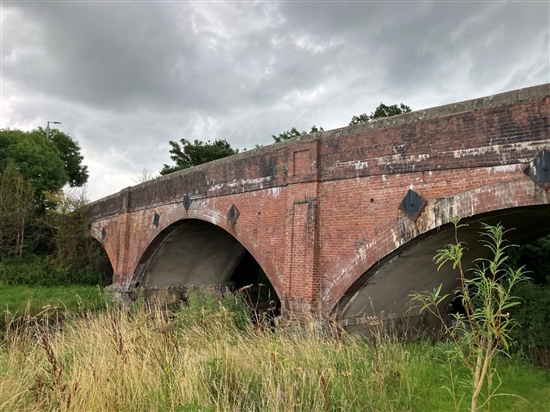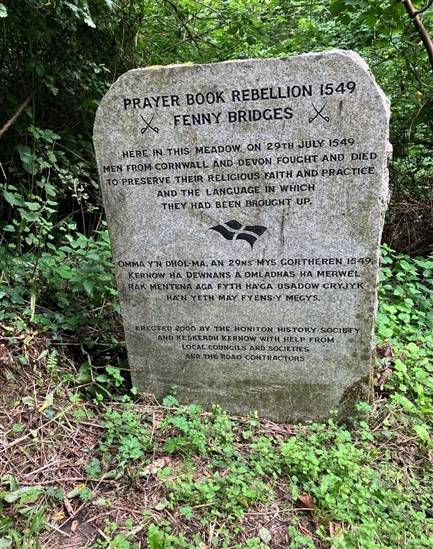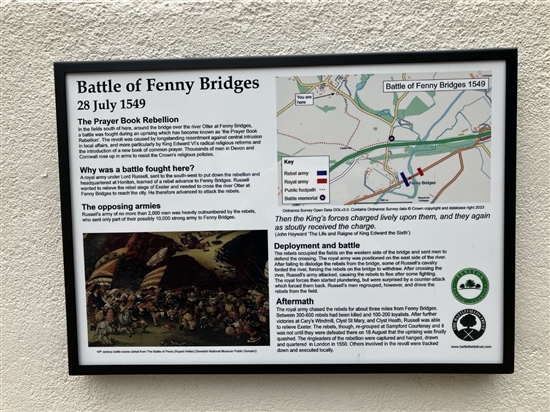Other pages about
Battle of Fenny Bridges
Battle of Fenny Bridges
28th July 1549
Name: Battle of Fenny Bridges
Date: 28 July 1549
War Period: Early Modern
Start Time and Duration: Morning, short duration.
Outcome: loyalist victory
Armies and Losses: Loyalists around 1700 men under John Russell, the Lord Privy Seal; Rebel army size unknown. Losses: Loyalists under 100; Rebels approximately 300.
Location: securely located at crossing of River Otter east of the modern village of Feniton.
Loyalist army repels insurgents’ reconnaissance-in-force from defended river crossing
Having finally received reinforcement and resupply over the preceding days, thanks to the financial assistance of Exeter merchants raising funds and troops in Bristol, Lyme, and Taunton, the King’s army was, at last, ready to take the initiative. Earlier skirmishers around Ottery St Mary, where Russell’s troops burned the town but encountered obstacles sufficient to prevent their movement on Exeter, provoked a rebel force to advance eastwards to Fenny Bridges, a mere three miles’ distant from the loyalist base at Honiton on the 27th of July. Whether through accident or design, Russell’s maneuvers had managed to draw the insurgents out to offer battle, albeit on ground of their choosing, at a crossing point over the River Otter. This presented the Lord Privy Seal with an opportunity to seize a vital bridgehead and eliminate the forces opposing him, which, encouraged by local landowners Sir Peter and Gawen Carew, he duly attempted the following morning.
The encounter saw loyalists compel an advance party to withdraw from the bridge before both armies clashed in a nearby meadow where the rebels had drawn up the remainder of their force, with the King’s army quickly attaining victory. The loyalists’ subsequent pursuit, however, was disrupted by a well-timed counterattack from concealed positions, after which they halted their advance for fear of further ambushes, allowing the bulk of the insurgents to escape into the surrounding countryside. While the action itself was relatively brief, pointing towards the superior equipment and experience of the loyalist army, the rebels nonetheless employed defensive positions and their greater knowledge of the terrain to limit their adversaries’ success and preserve their own forces. In this respect, the battle was a portent of the campaign to follow, wherein insurgents repeatedly surprised the King’s army with their high morale, stubborn resistance, ambushes, and counterattacks to the extent that Russell’s eventual victory was only attained through multiple sequential engagements.
The battlefield area has traditionally been sited north of the river crossing and main road in Fenny Meadow (known locally as ‘Bloody Meadow’), which would leave the rebels cut off from their line of retreat towards Exeter once they lost control of the bridge. A more likely location west of Feniton Bridge would allow the insurgents to anchor their right flank upon the River Otter and their left against possible embanked enclosures between the road and Skinner’s Ash Farm. This position would also sit astride or very near to the road to Exeter from which the rebels could both interdict Russell’s army and make their eventual withdrawal. Railways and road embankments have significantly impacted the traditional site, while the proposed alternative site remains highly vulnerable due to its close proximity to a built-up area (Feniton).
A monument to the battle is located a short distance north of the A30 along the eastern side of the minor road running between Fenny Bridges and Feniton. This commemorates the battle at the traditional site. An information board explaining the battle was installed by the Parish Council and Battlefields Trust in the car park at Feniton Village Hall (EX14 3BB) in July 2024.
An assessment of the Prayerbook Rebellion battlefields undertaken by Dr Glenn Foard and Alex Hodgkins on behalf of Devon County Council in 2009 is available to download from Archaeological Data Services at https://archaeologydataservice.ac.uk/library/browse/issue.xhtml?recordId=1208573.
This entry has been provided by Alex Hodgkins.












